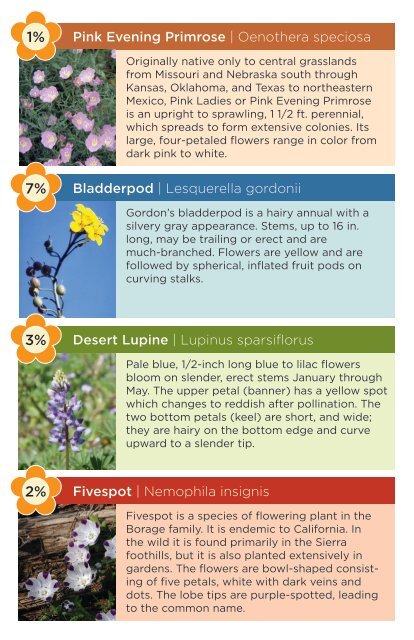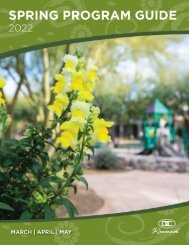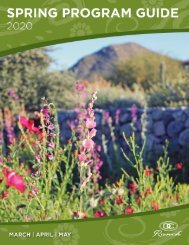Wildflower Guide
Create successful ePaper yourself
Turn your PDF publications into a flip-book with our unique Google optimized e-Paper software.
1%<br />
Pink Evening Primrose | Oenothera speciosa<br />
Originally native only to central grasslands<br />
from Missouri and Nebraska south through<br />
Kansas, Oklahoma, and Texas to northeastern<br />
Mexico, Pink Ladies or Pink Evening Primrose<br />
is an upright to sprawling, 1 1/2 ft. perennial,<br />
which spreads to form extensive colonies. Its<br />
large, four-petaled flowers range in color from<br />
dark pink to white.<br />
7%<br />
Bladderpod | Lesquerella gordonii<br />
Gordon’s bladderpod is a hairy annual with a<br />
silvery gray appearance. Stems, up to 16 in.<br />
long, may be trailing or erect and are<br />
much-branched. Flowers are yellow and are<br />
followed by spherical, inflated fruit pods on<br />
curving stalks.<br />
3%<br />
Desert Lupine | Lupinus sparsiflorus<br />
Pale blue, 1/2-inch long blue to lilac flowers<br />
bloom on slender, erect stems January through<br />
May. The upper petal (banner) has a yellow spot<br />
which changes to reddish after pollination. The<br />
two bottom petals (keel) are short, and wide;<br />
they are hairy on the bottom edge and curve<br />
upward to a slender tip.<br />
2%<br />
Fivespot | Nemophila insignis<br />
Fivespot is a species of flowering plant in the<br />
Borage family. It is endemic to California. In<br />
the wild it is found primarily in the Sierra<br />
foothills, but it is also planted extensively in<br />
gardens. The flowers are bowl-shaped consisting<br />
of five petals, white with dark veins and<br />
dots. The lobe tips are purple-spotted, leading<br />
to the common name.
















